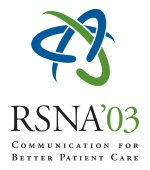
Abstract Archives of the RSNA, 2003
Hung-Ta Wu MD, PRESENTER: Nothing to Disclose
Abstract:
HTML
Purpose: In virgin patients, the MR diagnosis of carpal tunnel syndrome (CTS) is difficult. In the post-operative patient this difficulty is compounded. Consequently, we sought to evaluate for potential MR signs of post-op CTS.
Methods and Materials: At 1.5 T, 41 wrists in 37 patients with previous CTS release were evaluated by 2 observers for 1) flexor retinacular regrowth, 2) median nerve: a. high T2 signal , b. proximal enlargement , c. fibrous fixation, d. neuroma, e. laceration, f. entrapment. 3) flexor tenosynovitis. 4) mass; bursitis, accessory muscle, distal belly progression, or excessive deep fat. 5) hamate fracture, 6) volar nerve migration 7)tear of TFCC, scapholunate (SL), or lunotriquetral ligaments (LT). Electromyography (EMG), operative findings, and clinical follow-up were used to determine the presence of recurrent CTS.
Results: Reticular regrowth was seen in 27% with and 27% without recurrent CTS (p = .7), Excessive fat was seen in 7% with and 8% without CTS (p=.19). No patient had incomplete resection of flexor reticulum, scarring, entrapment; neuroma, nerve, or tendon laceration; bursitis, accessory or distal muscle progression of muscle belly, or hamate fracture. Nerve edema was seen in 27% with and 12% without CTS( p = .16 ); proximal enlargement in 40% with and 8% without CTS ( p = .007 ). Also 1 patient with recurrent disease demonstrated a mass. Tenosynovitis was seen in 60% with and 35% without recurrent CTS (p=.02). Counterintuitively, the nerve was more palmer with recurrent CTS then without (6.9 /8.9 mm). Of potential non-CTS causes of symptoms, SL tears were seen in 13% with CTS and 23% without CTS( p = .76).;LT tears in 7% with but none without CTS ( p = .26 ); and TFCC tears in 33% with and 27% without CTS ( p = .5 )
Conclusion: Only proximal enlargement, tenosynovitis, and the rare mass may help to diagnose recurrent CTS by MR. However, there appears to be a subgroup of patients with recurrent neuropathy related to an excessively superficial median nerve.
Questions about this event email: Mark.Schweitzer@mail.tju.edu
Wu MD, H,
Potential MR Signs of Recurrent Carpal Tunnel Syndrome. Radiological Society of North America 2003 Scientific Assembly and Annual Meeting, November 30 - December 5, 2003 ,Chicago IL.
http://archive.rsna.org/2003/3103849.html

